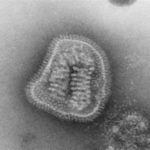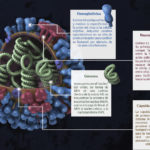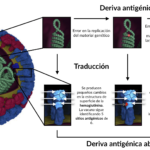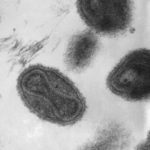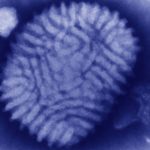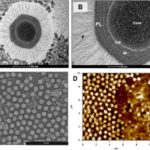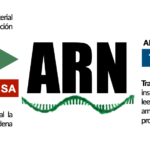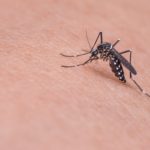El origen de los virus
- ARANDA ANZALDO, A. (1988) En la frontera de la vida: los virus. Proyecto La Ciencia para todos. México, D.F. [en línea] http://bibliotecadigital.ilce.edu.mx/sites/ciencia/volumen2/ciencia3/071/htm/sec_18.htm. Consultado por última vez el 15/08/2019
- CHUONG, E.B.; ELDE, N.C.; FESCHOTTE, C. (2016) Regulatory evolution of innate immunity through co-option of endogenous retroviruses. Science, 351(6277). pp: 1083-1087 | doi: 10.1126/science.aad5497
- MULET, J.M. (2011) Viroides: una reliquia viviente del mundo del ARN. Naukas.com [en línea] https://naukas.com/2011/10/19/viroides-una-reliquia-viviente-del-mundo-del-arn/. Consultado por última vez el 15/08/2019
- SCHOLTISSEK, C (1995) “Molecular evolution of influenza viruses”. Virus Genes, 11(2–3). pp: 209–215 | doi:10.1007/BF01728660. PMID 8828147
- LIU, S; KANG, J; CHEN, J; TAI, D; JIANG, W; HOU, G; CHEN, J; LI, J; HUANG, B (2009) FIELD, DAWN (ed.). Panorama phylogenetic diversity and distribution of type A influenza virus. PLoS ONE. 4 (3). pp: 1–20 | doi:10.1371/journal.pone.0005022. PMC 2658884. PMID 19325912
El virus Influenza
- Centro Nacional de Epidemiología, Instituto de Salud Carlos III (2018) Informe de Vigilancia de la Gripe en España, Temporada 2017-2018 (Desde la semana 40/2017 hasta la semana 20/2018). Disponible online: http://vgripe.isciii.es/documentos/20172018/InformesAnuales/Informe_Vigilancia_GRIPE_2017-2018_27julio2018.pdf
- Hause, B. M., Collin, E. A., Liu, R., Huang, B., Sheng, Z., Lu, W., … Li, F. (2014). Characterization of a novel influenza virus in cattle and Swine: proposal for a new genus in the Orthomyxoviridae family. mBio, 5(2), e00031–e14. doi:10.1128/mBio.00031-14
- International Committee on Taxonomy of Viruses (2016) Taxonomy history: Influenza D virus. Disponible online: https://talk.ictvonline.org/ICTV/proposals/2014.009a-dM.A.v2.InfluenzavirusD.pdf
- Boktor, S.W. & Hafner, J.W. (2019) Influenza. Treasure Island (FL): StatPearls Publishing. Disponible online: https://www.ncbi.nlm.nih.gov/books/NBK459363/
- Bouvier, N. M., & Palese, P. (2008). The biology of influenza viruses. Vaccine, 26 Suppl 4(Suppl 4), D49–D53. doi:10.1016/j.vaccine.2008.07.039
- Shtyrya, Y. A., Mochalova, L. V., & Bovin, N. V. (2009). Influenza virus neuraminidase: structure and function. Acta naturae, 1(2), 26–32.
- Gamblin, S. J., & Skehel, J. J. (2010). Influenza hemagglutinin and neuraminidase membrane glycoproteins. The Journal of biological chemistry, 285(37), 28403–28409. doi:10.1074/jbc.R110.129809
- Centers for Disease Control and Prevention (2017) Types of Influenza Viruses. Disponible online: https://www.cdc.gov/flu/about/viruses/types.htm
¿Por qué nos tenemos que vacunar de la gripe cada año?
- Bouvier N. M. (2018). The Future of Influenza Vaccines: A Historical and Clinical Perspective. Vaccines, 6(3), 58. doi:10.3390/vaccines6030058
- Lewnard, J. A., & Cobey, S. (2018). Immune History and Influenza Vaccine Effectiveness. Vaccines, 6(2), 28. doi:10.3390/vaccines6020028
- Centros para el Control y la Prevención de Enfermedades. – https://www.cdc.gov/flu
Diversidad Urbana
- P.J. Kerr, S.M. Myxoma virus in rabbits. Best. Rev. sci. tech. Off. int. Epiz., 1998, 1 7 (1), 256-268.
- Juan E. Echevarría (Centro Nacional de Microbiología. Instituto de Salud Carlos III). Comunicado de la Sociedad Española de Virología. 15 de Septiembre de 2018 – Publicado en PRENSA
- Plan de contingencia para el control de la rabia en animales domésticos en España. Dirección general de Sanidad de la reproducción agraria (ministerio de agricultura, alimentación y medio ambiente). Dirección general de salud pública, calidad e innovación (Ministerio de sanidad, servicios sociales e igualdad). Instituto de Salud Carlos III (Ministerio de economía y competitividad)
- Hoover, E. A., & Mullins, J. I. (1991). Feline leukemia virus infection and diseases. Journal of the American Veterinary Medical Association, 199(10), 1287-1297.
- Price, S. J., Garner, T. W., Nichols, R. A., Balloux, F., Ayres, C., de Alba, A. M. C., & Bosch, J. (2014). Collapse of amphibian communities due to an introduced Ranavirus. Current Biology, 24(21), 2586-2591.
¿Qué es el VIH?
- German Advisory Committee Blood (Arbeitskreis Blut), Subgroup ‘Assessment of Pathogens Transmissible by Blood’ (2016). Human Immunodeficiency Virus (HIV). Transfusion medicine and hemotherapy : offizielles Organ der Deutschen Gesellschaft fur Transfusionsmedizin und Immunhamatologie, 43(3), 203–222. doi:10.1159/000445852
- Santana, A.; Domínguez, C.; Lemes, A.; Molero, T. & Salido, E. (2003). Biología celular y molecular del virus de inmunodeficiencia humana (VIH). Revista de Diagnóstico Biológico, 52(1), 07-18. Recuperado en 07 de septiembre de 2019, de http://scielo.isciii.es/scielo.php?script=sci_arttext&pid=S0034-79732003000100001&lng=es&tlng=es.
- Centers for Disease Control and Prevention (2019) “About HIV/AIDS”. Disponible online: https://www.cdc.gov/hiv/basics/whatishiv.html
- UNAIDS (2019) “Trends of New HIV infections”. Disponible online: http://aidsinfo.unaids.org/
Agradecimientos:
- Gráfico del número de personas con VIH en 2017 basado en el planteado por Avert en “Number of people living with HIV in 2017” disponible en: https://www.avert.org/global-hiv-and-aids-statistics.
Clasificación de Baltimore
- Cann J. Alan. (2005). Principles of molecular virology. USA: Elsevier Academic Press
- Principles of Virology. Molecular Biology, Pathogenesis, and Control of Animal Viruses. S.J.Flint, L.W.Enquist, V.R.Racaniello, A.M.Skalka. Third edition. ASM PRESS. Washington, D.C. 2009.
¿Existen virus capaces de parasitar a otros virus?
- La Scola, B., et al. (2008). The virophage as a unique parasite of the giant mimivirus. Nature 455, 100-104.
“La tristeza de los cítricos”: la epidemia vírica que cambió la industria española
- Bertolini, E., Moreno, A., Capote, N., Olmos, A., de Luis, A., Vidal, E., Pérez-Panadés, J., & Cambra, M. (2008). Quantitative detection of Citrus tristeza virus in plant tissues and single aphids by real-time RT-PCR. European Journal of Plant Pathology, 120(2), 177-188.
- Cambra, M., Hermoso de Mendoza, A., Moreno, P., & Navarro, L. (1981). Use of enzyme linked immunosorbent assay (ELISA) for detection of citrus tristeza virus (CTV) in different aphid species. Proceedings of 4th International Society of Citriculture, pp. 444–448, Japan.
- Cambra, M., Camarasa, E., Gorris, M. T., Garnsey, S. M., Gumpf, D. J., & Tsai, M. C. (1993). Epitope diversity of citrus tristeza virus isolates in Spain. In International Organization of Citrus Virologists Conference Proceedings (1957-2010) (Vol. 12, No. 12).
- Cambra, M., Gorris, M. T., Marroquın, C., Román, M. P., Olmos, A., Martınez, M. C., Hermoso de Mendoza, A., & Navarro, L. (2000). Incidence and epidemiology of Citrus tristeza virus in the Valencian Community of Spain. Virus Research, 71(1-2), 85-95.
- Cambra, M., Gorris, M. T., Olmos, A., Martínez, M. C., Román, M. P., Bertolini, E., López, A., & Carbonell, E. A. (2002). European diagnostic protocols (DIAGPRO) for Citrus tristeza virus in adult trees. In International Organization of Citrus Virologists Conference Proceedings (1957-2010) (Vol. 15, No. 15).
- Gottwald, T. R., Cambra, M., Moreno, P., Camarasa, E., & Piquer, J. (1996). Spatial and temporal analyses of citrus tristeza virus in Eastern Spain. Phytopathology, 86, 45–55.
- Marroquín, C., Olmos, A., Gorris, M. T., Bertolini, E., Martínez, M. C., Carbonell, E., et al. (2004). Estimation of the number of aphids carrying Citrus tristeza virus that visit adult citrus trees. Virus Research, 100, 101–108.
- Mehta, P., Brlansky, R. H., Gowda, S., & Yokomi, R. K. (1997). Reverse transcription polymerase chain reaction detection of citrus tristeza virus in aphids. Plant Disease, 81, 1066–1069.
- Moreno, P., Ambros, S., Albiach‐Martí, M. R., Guerri, J., & Pena, L. (2008). Citrus tristeza virus: a pathogen that changed the course of the citrus industry. Molecular plant pathology, 9(2), 251-268.
- Olmos, A., Cambra, M., Esteban, O., Gorris, M. T., & Terrada, E. (1999). New device and method for capture, reverse transcription and nested PCR in a single closed tube. Nucleic Acids Research, 27, 1564–1565.
- Yokomi, R. K., Garnsey, S. M., Civerolo, E. L., & Gumpf, D. (1989). Transmission of exotic citrus tristeza isolates by a Florida colony of Aphis gossypii. Plant Disease, 73, 552–556.
Los virus transmitidos por insectos vectores: “los arbovirus”
- Morens & Fauci (2013). Emerging infectious diseases: threats to human health and global stability. Plos Pathog, 9, e1003467.
- Goddard (2008). Infectious diseases and arthropods. Springer Science.
- Gubler (1998). Resurgent vector-borne diseases as a global health problem. Emerg Infec Dis, 4, 442.
- Calvet et al. (2016). Detection and sequencing of Zika virus from amniotic fluid of fetuses with microcephaly in Brazil: a case study. Lancet Infect Dis, 16, 653-660.
- Gutiérrez-López et al. (2019). Vector competence of Aedes caspius and Ae. albopictus mosquitoes for Zika virus, Spain. Emerg Infec Dis, 25, 346.
- Heitmann et al. (2017). Experimental transmission of Zika virus by mosquitoes from central Europe. Eurosurveillance, 22.
- Yixin et al. (2015). Wolbachia reduces the transmission potential of dengue-infected Aedes aegypti. PLoS Negl Trop Dis, 9, e0003894.
